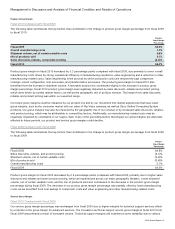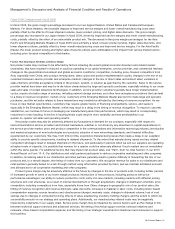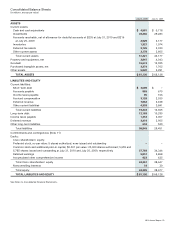Cisco 2010 Annual Report Download - page 33
Download and view the complete annual report
Please find page 33 of the 2010 Cisco annual report below. You can navigate through the pages in the report by either clicking on the pages listed below, or by using the keyword search tool below to find specific information within the annual report.
Management’s Discussion and Analysis of Financial Condition and Results of Operations
Liquidity and Capital Resources
The following sections discuss the effects of changes in our balance sheet, contractual obligations, other commitments, and the
stock repurchase program on our liquidity and capital resources.
Balance Sheet and Cash Flows
Cash and Cash Equivalents and Investments The following table summarizes our cash and cash equivalents and investments (in
millions):
July 31, 2010 July 25, 2009
Increase
(Decrease)
Cash and cash equivalents $ 4,581 $ 5,718 $ (1,137)
Fixed income securities 34,029 28,355 5,674
Publicly traded equity securities 1,251 928 323
Total $ 39,861 $ 35,001 $ 4,860
The increase in cash and cash equivalents and investments was primarily the result of cash provided by operating activities of
$10.2 billion in fiscal 2010, an increase from $9.9 billion in fiscal 2009, as well as the issuance of $5.0 billion of senior notes in
November 2009, and the issuance of common stock of $3.3 billion related to employee stock option exercises and employee stock
purchases. These factors were partially offset by the repurchase of common stock of $7.9 billion, business acquisitions totaling
$5.3 billion and capital expenditures of $1.0 billion.
The $276 million increase to cash provided by operating activities in fiscal 2010 was the net result of a favorable impact to
operating cash flows from increased net income and increased deferred revenue, partially offset by the unfavorable impact to
operating cash flows from increased accounts receivable.
Our total in cash and cash equivalents and investments held outside of the United States in various foreign subsidiaries was
$33.2 billion and $29.1 billion, as of July 31, 2010 and July 25, 2009, respectively. The remaining balance held in the United States
as of July 31, 2010 and July 25, 2009 was $6.7 billion and $5.9 billion, respectively. Under current tax laws and regulations, if cash
and cash equivalents and investments held outside the United States are distributed to the United States in the form of dividends or
otherwise, we may be subject to additional U.S. income taxes (subject to an adjustment for foreign tax credits) and foreign
withholding taxes.
We maintain an investment portfolio of various holdings, types, and maturities. We classify our investments as short-term
investments based on their nature and their availability for use in current operations. We believe the overall credit quality of our
portfolio is strong and our fixed income investment portfolio consists primarily of the highest quality investment-grade securities.
We believe that our strong cash and cash equivalents and investments position allows us to use our cash resources for strategic
investments to gain access to new technologies, acquisitions, customer financing activities, working capital, and the repurchase of
shares of common stock.
We expect that cash provided by operating activities may fluctuate in future periods as a result of a number of factors,
including fluctuations in our operating results, the rate at which products are shipped during the quarter (which we refer to as
shipment linearity), the timing and collection of accounts receivable and financing receivables, inventory and supply chain
management, deferred revenue, excess tax benefits from share-based compensation, and the timing and amount of tax and other
payments. For additional discussion, see “Part I, Item 1A. Risk Factors” in our 2010 Annual Report on Form 10-K.
Accounts Receivable, Net The following table summarizes our accounts receivable, net (in millions), and DSO:
July 31, 2010 July 25, 2009
Increase
(Decrease)
Accounts receivable, net $ 4,929 $ 3,177 $ 1,752
DSO 41 34 7
Our accounts receivable, net increased during fiscal 2010 due to our higher revenue in fiscal 2010 as compared with fiscal 2009,
and higher days sales outstanding (DSO) in fiscal 2010 as well. Our DSO as of July 31, 2010 increased from the previous fiscal year
end due to the timing of product shipments in the fourth quarter of fiscal 2010 as compared with the same period in fiscal 2009,
partially offset by stronger collections in the later part of fiscal 2010.
2010 Annual Report 31
























